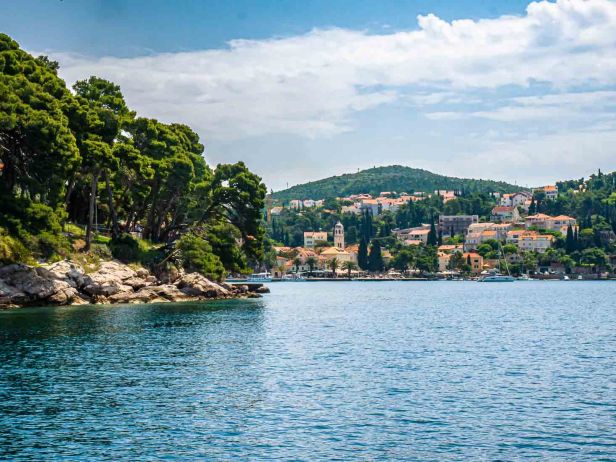
Cursed!
In the 11th century an abbey and monastery was founded on Lokrum Island. It was run by a powerful Catholic order of Benedictines.
By the 1800’s Dubrovnik was in financial trouble so it was decided to sell the island, and the Benedictines had to leave. It had been their home for hundreds of years. They were pissed!
After their last Mass, pulling their hoods over their heads they circled the island, dripping a trail of candle wax as they went and chanting “Whosoever claims Lokrum for his own personal pleasure shall be damned”.
Okay then.
Fifty years later Lokrum is sold to private contractors. Two members of the aristocracy were responsible for the sale.
One jumped (or fell or was pushed?) out a window. Dead
The other hanged himself. Or was killed by a servant. Dead.
A third involved drowned near Lokrum. Dead.
The next owner of the island suddenly lost his fortune soon after purchasing the island. Not dead but had to sell the island.
The next owner, a lawyer to the Emperor of the Austro-Hungarian Empire, was suddenly discovered to be a fraud.
The next, his nephew, hit bad weather on the way to the island and drowned. Dead.
Archduke Maximillian came next, building a retreat on the island for himself and his wife Charlotte. He became emperor of Mexico, but was executed by insurgents. Dead.
Charlotte was devastated and killed herself. Or perhaps she was murdered. Dead.
Their son committed suicide. Dead.
The next victim of the curse was Otto Friedrich Wilhelm, King of Prussia. After spending a summer on Lokrum, he was declared a lunatic by the Bavarian Council and lost his reign. Later, he was found in a nearby lake. Dead.
His son Rudolf inherited Lokrum. He had periods of insanity and murdered his mistress, then committed suicide. Both dead.
Austrian Archduke Franz Ferdinand planned to visit Lokrum, but was assassinated before he got there. Dead.
His assassination prompted the First World War. Many many dead.
Stories continue to circulate – about fishermen who have disappeared with their boats, and people who’ve visited at night and never returned.
No one lives on Lokrum today. And no one is allowed to stay overnight. Who would want to? Apparently those Benedictine monks knew a thing or two about casting spells.
But happily we don’t know any of this so off we go to Lokrum.
These days the tiny island, less than one square kilometre in size, and only fifteen minutes by ferry from Dubrovnik, is a Nature Reserve. No cars are allowed, and the island is thickly covered with laurel, oak, pine, and cypress forests criss-crossed by many walking trails.
There are several rocky beaches, the Gothic-Renaissance Benedictine Monastery, which (mostly) still stands, there are ruins from the buildings that were destroyed in the 1667 earthquake,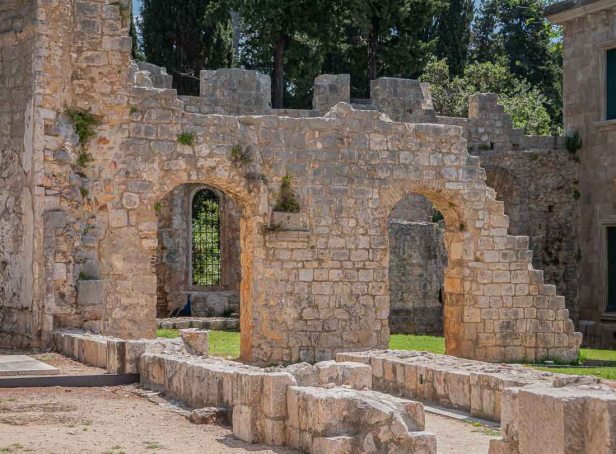
and, thanks to Archduke Maximilian, there’s a botanical garden, with several hundred different kinds of trees and plants.
But for me the stars of Lokrum are: the Dead Sea. The hike to the highest point. The peacocks! Another gift from old Max. They are such extraordinary creatures,

showing us what it really means to shake a tail feather. Come on let me see you shake a tail feather.
We eat. After lunch, which I only remember because of the photo,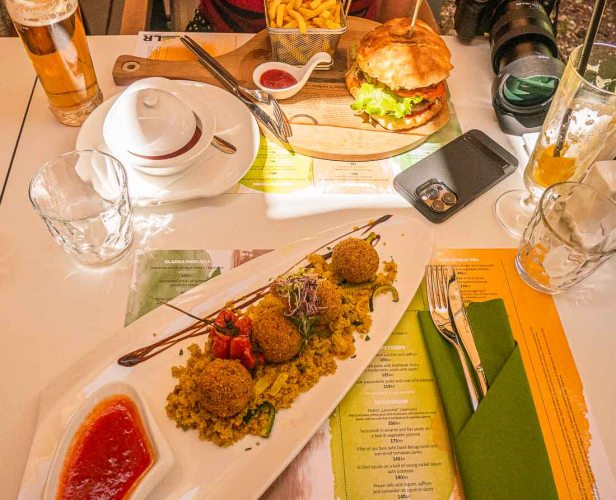
we begin the long march to the top, to the highest point of the island where stands Fort Royal Castle, a grand lookout tower built by the French when Napoleon was boss. Lokrum Island, just 600 metres from the mainland, provided, back when it mattered, additional protection for Dubrovnik, a sentinel that sees all that approaches by sea; especially if you build a big round stone tower at the highest point.
Our journey to the top begins as a stroll along well-maintained paved, then dirt paths, climbing up a few stairs now and then, reading signs and hoping we’ve got the direction right.
It’s spring. There are wildflowers everywhere, along the verge,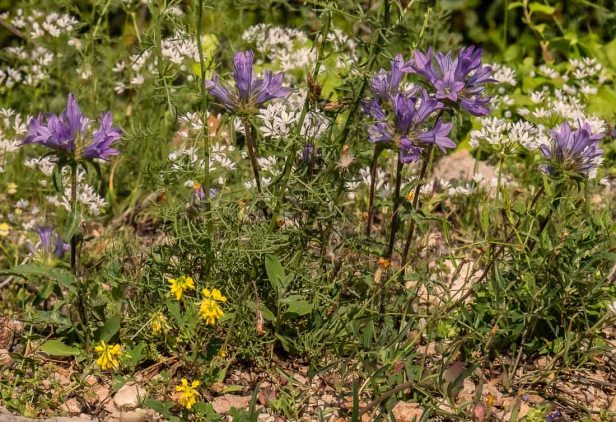
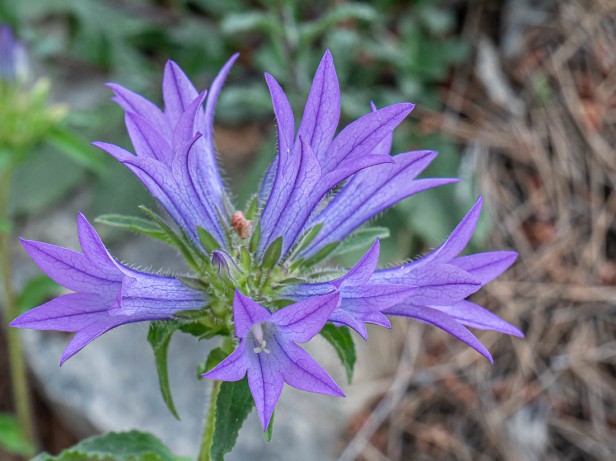
and bursting resolutely from between the rocks that line the path.
As we go higher the path becomes narrower, the forest closes in.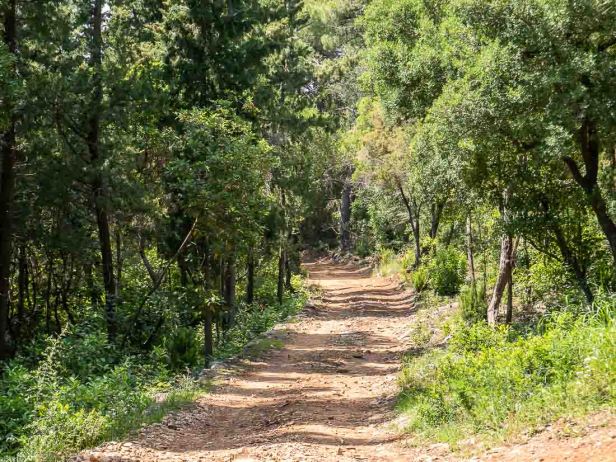
And then higher still it becomes a mad grubby scramble over rocks, and there are several choices of barely discernible trail for the final ascent. We just keep climbing, following the voices of those above us who’ve already made it.
At the top I’m not so impressed by the big stone tower. I maybe would have been if I was able to get inside but it was locked. What does impress me is the view back to Dubrovnik. Worth it!
Back down the mountain we go and walk to the other end of the island to the Dead Sea.
I gently unravel when we get there, muscles relaxing as I release the tension from the exertion of the hike. It’s wild and beautiful, this small lake with rocky shores, a cliff on one side
and a rock wall with stairs on the other, surrounded by pine trees dipping down to the water, the green clear water rippling gently in the sun.
No surprise, Mrtvo More is very salty. The lake, ten metres deep, is fed from a series of caves and fractures in the land that connect it to the sea. It is thought to be the result of the collapse of a huge cavern, not unlike the cenotes in Mexico. The water is calm, warmer than the ocean, and protected from the wind. There are fish, and a grotto beneath the overhanging rock wall.
I watch as S swims; I watch her easy enjoyment in the cool water, swimming, floating, swimming, and then when she’s getting out she plays for the camera so I can get some splashy photos.
We find a shaded area and sit. It’s a place to unwind; its busy enough but not crowded, people are happy here, relaxed. Contentment arises.
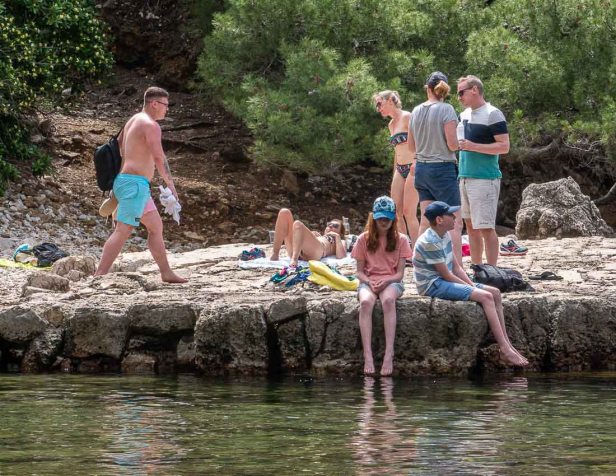
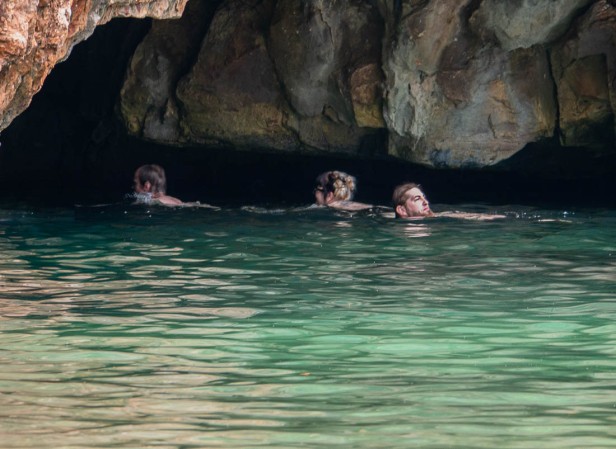
With one last look back,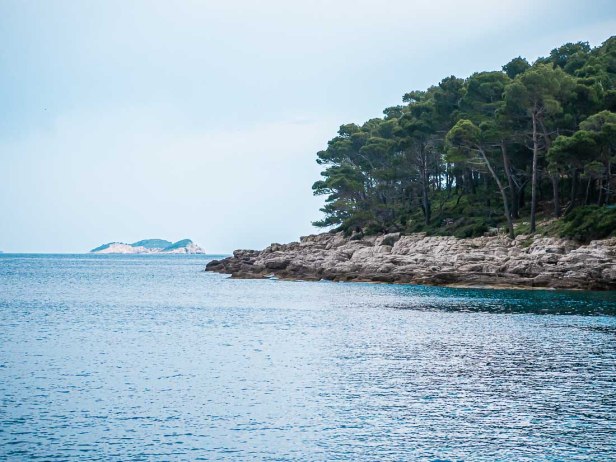
we return on the little ferry to Dubrovnik, reconnect with L and eat ice cream as the day softly comes to an end. Sweet. The evening was not so sweet, but I’ve already told that story.
Another day another ferry.

Leaving Dubrovnik
we travel twenty kilometres south, down the coast to Cavtat.
Ah the joys of learning to pronounce words in a foreign language. It’s Savtat not Kavtat, and the reason goes back to antiquity. Of course it does.
The original city, known as Epidaurus was founded by the Greeks in the 6th century BCE. The surrounding area was inhabited by the Illyrians, who called the city Zaptal. The town changed its name to Epidaurum when it came under Roman rule. It later came under Byzantine rule, then was ransacked and destroyed by the Avars and Slavs in the 7th century. And that was the end of Epidaurum. Or Zaptal.
Refugees from Epidaurum fled to Lokrum Island. Back then Lokrum was known as Laus, which became Raus, then Ragusa, and eventually the community was absorbed into the powerful Republic of Ragusa, with Dubrovnik as the main port and city.
In the Middle Ages a town was re-established, and inevitably came under the control of the Republic of Ragusa. The town became known as Civitas Vitas, Latin for Old Town, and civitas evolved into Cavtat pronounced with a soft ‘c’ like civitas. I’m intrigued by the coincidence that the town is now known as Cavtat and that the Illyrians way back in the 6th century BCE called it Zaptal. They are such similar names that despite the connection between Cavtat and civitas you’ve gotta think that there’s also a connection between Cavtat and Zaptal.
Anyway, enough of that. We’ve arrived. It’s a warm and sunny day, and from the ferry Cavtat looks ravishing! Another gorgeous place on the Dalmatian Coast of Croatia. It’s a part of the world that just keeps on giving.
Cavtat is all about the setting – two small peninsulas creating two protected bays, the town sequestered deep in the bay between the two peninsulas and extending south and inland, pine and cypress covered mountains behind, and the ever-changing hypnotic blues of the Adriatic in front.
There’s a seaside promenade where the ferry docks, and from the promenade a walking path around the northern peninsula.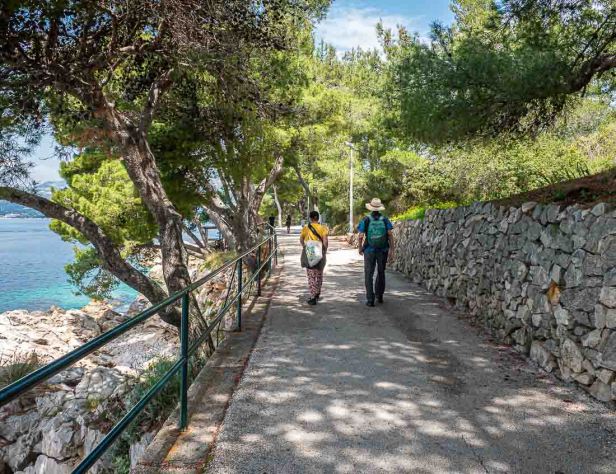
It’s a pleasant stroll in a very pretty place past pebbly and rocky beaches, sunbathers, a beach bar built into the low cliff, lovely views of the water and mountains, and cypress trees, exclamation marks in the landscape that remind me of Tuscany.

Instead of letting myself relax, and God knows I need some of that, I start to get antsy. I want something more than pleasant! I want to explore! I notice a path up the hill and without saying a word I dash up there.
It gets narrower but I keep climbing.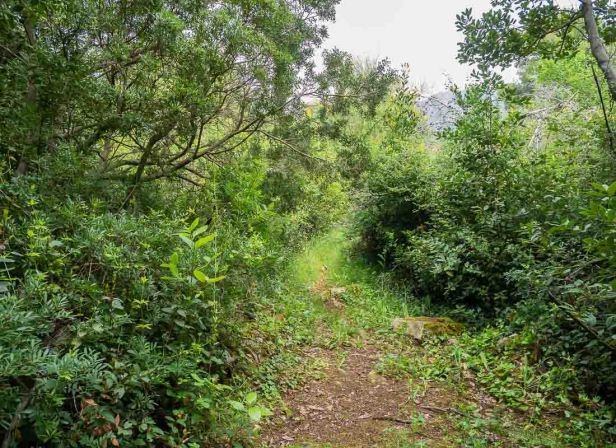
After a short time I come to a field of long sweet grasses and wild flowers,
and a peekaboo view of nearby islands. I love untamed places; everything in me seems to loosen and expand.
I rejoin the others and we continue on until we arrive back at the harbour with its gently lapping waters and fishing boats,

and so finally back to the promenade.

Some of the people I’m travelling with really enjoy a long slow lunch, sampling the local dishes and wines. It’s their thing, it’s one of the things they enjoy most about travelling, but it’s pretty much at the bottom of the list for me. I like nice food, and I love ice cream (it’s a food group isn’t it?), but really I only eat to stop from starving, so after lunch I’m off exploring again. Up behind the promenade is a town. Where people live. And I want to see it.
It’s all narrow ancient streets, stone houses, the promise of lush gardens behind crumbling walls,
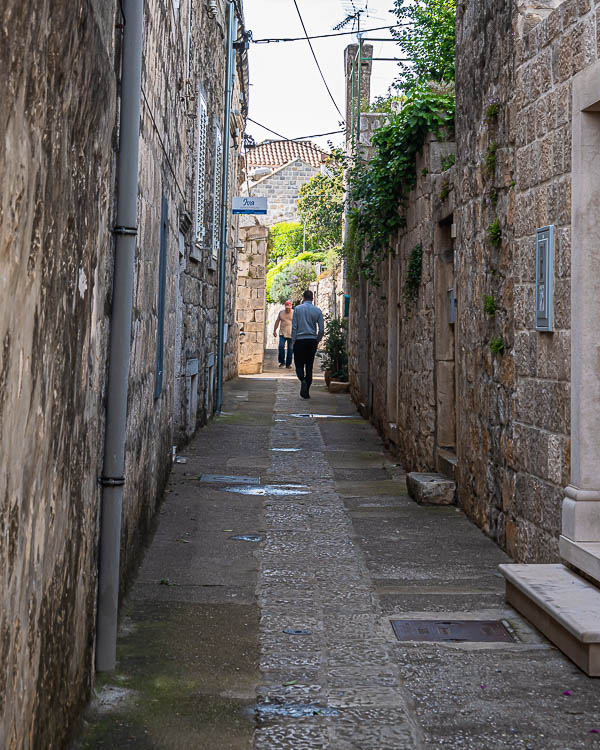

and cats that challenge my right to be there.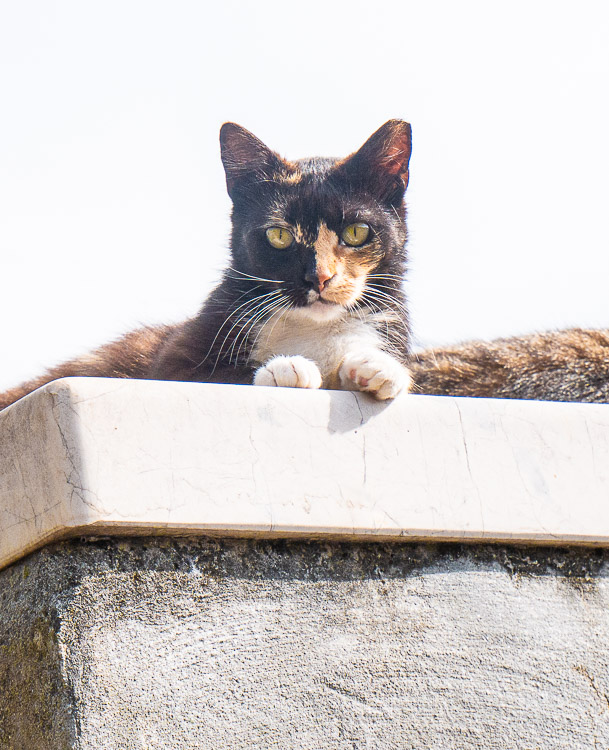
Now it’s time for the ferry back to Dubrovnik; one last shot of Cavtat as we leave.
There may or may not have been ice cream at the end of this day too.
Disclaimer: In diving into the history of the Lokrum curse, I discovered that the details of the people who either lost their fortune and/or their sanity and/or their life vary somewhat from site to site. If you’re curious to know more, the most thorough account seems to be here.
All words and images by Alison Louise Armstrong unless otherwise noted
© Alison Louise Armstrong and Adventures in Wonderland – a pilgrimage of the heart, 2010-2022.

What an interesting place! The Curse sounds fascinating and would certainly deter ownership.
I love your wanderings, and I share your opinion on interesting food tastings. 😃
One can always eat, but exploring is tops in my book.
LikeLiked by 1 person
Thanks so much Pat. It’s lovely to hear that you’re enjoying our wanderings.
I’d heard Lokrum had been cursed by the monks, but when I looked into it I was amazed by how much misfortune was associated with those who tried to live there.
I agree! One can always eat, exploring trumps everything! Except ice cream 😂
Alison
LikeLike
I love to go off the beaten track as well and explore. I have discovered the most amazing things that way. But others are not so keen. I enjoyed the story of the curse and the pictures are amazing.
LikeLiked by 1 person
Thanks Darlene I’m glad you enjoyed it. I do love telling the stories of our travels. And sharing the photos of course.
I’m sooo curious! It has definitely gotten me into trouble 😂 but is usually very rewarding.
Alison
LikeLike
30 plus years ago we took a boat from Dubrovnik harbour to Cavtat, but we didn’t visit Lokrum. I don’t feel we missed much. I seem to remember a border being close by, but this was before that destructive war.
LikeLiked by 1 person
I enjoyed the trip to Cavtat, but liked Lokrum better – at least I had more fun there. There is a border just south of Cavtat – Montenegro. We thought of doing a day trip there but it seemed like too much in one day.
Alison
LikeLike
Yes, the Montenegran border. I always intended to return and explore further north and south, but it hasn’t happenede yet.
LikeLiked by 1 person
After all those dead bodies, I was hoping that you’d have a great time. Obviously you did.
LikeLiked by 1 person
We did have a great time. It was a fun day.
BTW I’ll be in Canberra for 2.5 months from early Dec. Would love to meet!
Alison
LikeLiked by 1 person
That would be fantastic. Keep me posted.
LikeLiked by 1 person
Will do.
A.
LikeLiked by 1 person
What a nice historic narrative! Great pictures!
LikeLiked by 1 person
Thank you so much. I’m glad you enjoyed it.
Alison
LikeLike
Ice cream is most definitely a food group! And I share your feelings about food – when I’m exploring, I want to spend every moment taking in where I’m at. Food is for evening when the historic places are closed. 😛
I have to say, good on those Lokrum monks! It does beg the question, though – does that group exist today? Should they be given back their cursed island? Could they even remove the curse if they wanted to? There’s definitely a novel (or three) in those ideas.
LikeLiked by 1 person
Exploring is definitely at the top of my list. Food is pretty far down unless I’m about to expire from starvation. But yay ice cream!
I would imagine there are Benedictine monks still around today though I doubt any could legit lay claim to Lokrum.
Alison
LikeLike
What beautiful places! I’ve read about Lokrum Island before but I had no idea of the curse. That’s quite a long list of people whose final days were tied/related to this otherwise small island. Your previous post on Dubrovnik and this one on Lokrum and Cavtat really pushed these places along the Dalmatian Coast up my wish list, Alison.
LikeLiked by 1 person
Thanks Bama, glad to hear I’m inspiring you. The Dalmatian coast is really quite special.
I didn’t know of Lokrum’s curse either until I started researching it. Fascinating story.
Alison
LikeLiked by 1 person
The Lokrum curse sounds like something from the Game of Thrones. it is fitting the Archduke Ferdinand was headed there.
That area looks so spectacular. I love how Europe has preserved so many of the old cities and buildings.
LikeLiked by 1 person
The Lokrum curse is so fascinating, especially given all the deaths/insanity/loss of fortunes associated with it. Lokrum is actually used for one of the GOT settings!
Indeed, the area is spectacular – everywhere we went on the Dalmatian coast was beautiful. And I too love how much of Europe is preserved – it feels like being in a huge open-air museum.
Alison
LikeLike
Your photos make me really want to visit Croatia! I’ve somehow managed to skip it, as I have ventured to the Slovenian coast, as well as Montenegro, Italy and Albania. And ice cream is absolutely a necessary food group! Happy travels!
LikeLiked by 1 person
Thanks so much Whitney – I’m happy to have inspired you to visit Croatia! The Dalmatian coast really is beautiful.
Of the countries you mentioned I’ve only been to Italy. We did look into doing a day trip from Dubrovnik to Montenegro but decided it would just be too rushed.
Alison
LikeLike
Best that you didn’t know the history of Lokrum before you went. It seemed worth the journey. I’m not superstitious but it would have given me pause. Love the photos, as always.
LikeLiked by 1 person
Thanks so much Ruth. I think I’d have still gone even if I knew about Lokrum. I can be superstitious occasionally, but the curse seems pretty remote these days – and I wasn’t trying to take it over and live there. I enjoyed Lokrum. It was quite lovely.
Alison
LikeLiked by 1 person
Great stories, though!
LikeLiked by 1 person
Oh yes!
LikeLike
Alison, this post really pulled me in from the first word. Had no idea about the Lokrum curse… There are several truly awful world leaders who I think should take up ownership of the island to make all our lives easier. And now you know how those random peacocks ended up there! I do love the look of Cavtat, and can totally see why some of the group felt it was the right place for a long leisurely lunch. However I completely understand why you were getting antsy given the limited time you had there. Bama and I may be foodies, but we are both fast eaters!
For a while there was talk of organizing a big family trip to Croatia (one of my uncles in Canada is an architect and is ticking off as many UNESCO World Heritage sites as he can), but that was meant for May 2020 and, well, we all know what happened.
LikeLiked by 1 person
Thank you so much. It’s always good to hear I’ve captured the reader’s attention.
I do agree there are several leaders should take up ownership of Lokrum. It could help a lot I think.
As day visitors we really enjoyed our time there, and lived to tell the tale!
Cavtat is lovely, but for sure I have a different travel style than some of the others so at times it took some adjustment on my part. I’m glad we went, and the ferry rides were fun as well. I’d be with you and Bama as fast eaters – have a meal and then get exploring!
Too bad your trip to Croatia had to be cancelled. It’s a very beautiful country.
Alison
LikeLiked by 1 person
We’re in the food-and-wine-savoring camp, but I have been known to get antsy when such indulgences take too long – time to get out exploring again! So I guess you could say I’m fond of both 🙂 Your description of Lokrum Island was fascinating, and the mention of Maximillian and Charlotte especially caught my eye. In Mexico City, we toured the hilltop castle where they resided during his short tenure as Emperor of Mexico. I wonder if they ever got back to their Lokrum retreat before their deaths?
xo
Susan
LikeLiked by 1 person
First, thanks for reading, and thanks for all your comments. xo
I don’t mind leisurely meals in the evening, but when it’s for lunch it seems to take up way too much time for me. On my own I’d grab some street food and carry on, and often we’d make sandwiches in the morning for the day and just stop for coffee/tea somewhere. Food overall has never been a focus for us. I’d been blogging for years before I thought to mention what we were eating 😂.
I really enjoyed Lokrum, and exploring the history was also a fascinating journey. I wonder if I’ll ever get back to CDMX. If I do I’ll be going to Max and Charlotte’s castle for sure! He was killed in Mexico by insurgents. I don’t know if she ever got back to Lokrum or not, though I’d guess not.
Alison
LikeLike
Wow! Such a strong curse, especially before WWI. Perhaps it’s the reason for some bad luck during this trip 😛 But honestly, the island looks great!
LikeLiked by 1 person
Lokrum is lovely, and I’m really glad we went, but yes, that curse! It sure was (is?) powerful. Maybe it did affect us – we hadn’t really had any bad luck until after we went to Lokrum! 😳
Alison
LikeLiked by 1 person